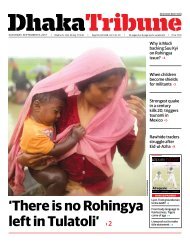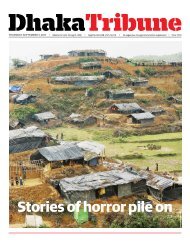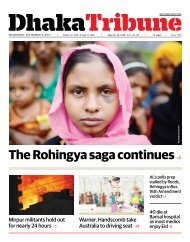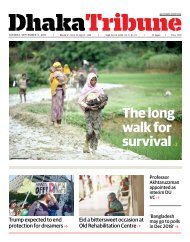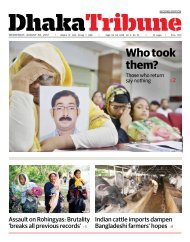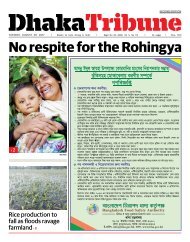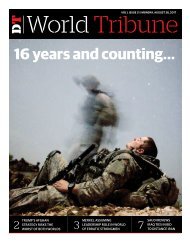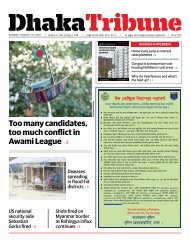e_Paper, Tuesday, December 13, 2016
You also want an ePaper? Increase the reach of your titles
YUMPU automatically turns print PDFs into web optimized ePapers that Google loves.
DT<br />
12<br />
Business<br />
TUESDAY, DECEMBER <strong>13</strong>, <strong>2016</strong><br />
CAPITAL MARKET SNAPSHOT: MONDAY<br />
DSE Broad Index 4,869.6 0.2% ▲ Index 1,157.1 0.2% ▲ 30 Index 1,785.6 0.1% ▲ Turnover in Mn Tk 7,412.4 -10.0% ▼ Turnover in Mn Vol 2<strong>13</strong>.8 -27.1% ▼<br />
CSE All Share Index 14,968.6 -0.1% ▼ 30 Index <strong>13</strong>,295.0 -0.4% ▼ Selected Index 9,081.7 -0.1% ▼ Turnover in Mn Tk 456.7 -3.7% ▼ Turnover in Mn Vol 16.8 -15.8% ▼<br />
ILO: Most female SME owners hardly get loans<br />
Women entrepreneurs say long application process a big barrier to access to funds<br />
• SM Najmus Sakib<br />
Over 60% women Small and Medium<br />
Enterprise (SME) entrepreneurs<br />
in Bangladesh do not get<br />
loans neither from the government<br />
nor the private loan providers, says<br />
a study of ILO, Bangladesh.<br />
On the other hand, 88% SME<br />
women entrepreneurs expressed<br />
their dissatisfaction over the cumbersome<br />
loan application process<br />
that is a great barrier in the way of<br />
getting their desired loans, view<br />
specialists at ‘Dhaka summit on<br />
skill, employment and decent work<br />
<strong>2016</strong>’ held at a city hotel yesterday.<br />
During his presentation, Francis<br />
De Silva, senior specialist of ILO<br />
Bangladesh, stated that the average<br />
loan size for women-owned SMEs<br />
is 47% less than the amount SMEs<br />
owned by men, and 36% of women<br />
reported gender-bias among financial<br />
institutions.<br />
“And to get loan, women needed<br />
nearly <strong>13</strong> time visits to the bank to<br />
get their loan approved,” he further<br />
added.<br />
According to the ILO survey,<br />
nearly 70% of the women entrepreneurs<br />
in Bangladesh are in micro<br />
and rural enterprises and overall<br />
demand for finance among women-owned<br />
SMEs is estimated to be<br />
approximately Tk9,975 crore.<br />
As an initiative to promote<br />
women entrepreneurship, the<br />
Ministry of Women and Children<br />
Affairs jointly with a2i, SME foundation<br />
and Bangladesh Women in<br />
Technology (BWIT) have fixed a<br />
target to develop 3,000 women as<br />
ICT entrepreneurs and freelancers<br />
from the remotest and under-privileged<br />
areas across the country.<br />
10 million migrant workers<br />
stayed abroad till November,<br />
<strong>2016</strong> and sent remittance worth<br />
US$12.49 billion, said Anir Chowdhury,<br />
a policy advisor of the Prime<br />
Minister Office.<br />
He said: “Apprenticeship is less<br />
costly to recruit than adult and experience<br />
workers and condition of<br />
Bangladesh is yet to be a satisfactory<br />
one compare to the developed<br />
and developing countries in giving<br />
access to the industries.”<br />
“Apprenticeship helps improve<br />
companies’ productivity and<br />
people who have trained as<br />
apprentice are likely to stay with<br />
that company, skilling people in<br />
target areas meet business need<br />
and help employers to overcome<br />
structural barriers which will<br />
ultimately be beneficial for the<br />
industries,” he reads.<br />
Under ‘Apprenticeship programme<br />
in informal sectors for<br />
unemployed youths’ a2i (is a key<br />
driver from PM office to operate<br />
skill development programmes) in<br />
partnership with ILO has started<br />
skill development in 600 informal<br />
industries and workshops in 30<br />
Upazillas and 1200 unemployed<br />
youths were receiving training,<br />
says the ILO study. •<br />
Curriculum revision needed to develop skilled workforce<br />
• Ibrahim Hossain Ovi<br />
Experts suggested revision of education<br />
curriculum to produce<br />
need-based skilled workforce as<br />
demand for skills continues to rise.<br />
“Generation of about 15m new<br />
jobs are projected over the next 10<br />
years in the country’s seven thrust<br />
sectors including garment, export-oriented<br />
manufacturing, light<br />
engineering, shipbuilding, agriculture,<br />
ICT and pharmaceuticals,” said<br />
Md Mokhlesur Rahman of the World<br />
Bank in his key note presentation at<br />
a seminar in Dhaka yesterday.<br />
The seminar titled “Skill for Decent<br />
Employment: An Effective<br />
Mean of Social Transformation”<br />
was held at the Dhaka Skill Summit.<br />
Metropolitan Chamber of Commerce<br />
and Industry President Syed<br />
Nasim Manzur moderated the seminar.<br />
Mokhlesur Rahman urged to<br />
increase the share of students in<br />
A woman sews nakshikantha in Jessore. The women SME entrepreneurs in the country struggle to run business due to lack of<br />
fund<br />
SYED ZAKIR HOSSAIN<br />
the Technical Vocational Education<br />
and Training (TVET) system to<br />
25% by expanding access to quality<br />
technical vocational education and<br />
training.<br />
Dhaka University Associate Professor<br />
of Economics Sayema Haque<br />
Bidisha was co-presenter of the<br />
keynote paper.<br />
She also found that the country’s<br />
education curriculum is not in<br />
consistent with the industry’s demand<br />
and called for making skillbased<br />
curriculum.<br />
Principal Secretary to Prime<br />
Minister Abul Kalam Azad the government<br />
has taken several initiatives<br />
to increase skilled workforce.<br />
According to the World Bank<br />
data, Bangladesh’s industrial production<br />
increased by an estimated<br />
10.1%, driven by growth in large<br />
and medium scale manufacturing<br />
and construction, while the service<br />
sector growth accelerated from<br />
5.8% in FY2015 to 6.7% in FY<strong>2016</strong>.<br />
The data said there are shortages<br />
of semi-skilled and skilled<br />
people in general, but the highest<br />
skill gap is in the agro-food sector<br />
followed by the RMG and IT.<br />
Sramik League Leader Shamsun<br />
Nahar Buiyan said the workers migrate<br />
to Dhaka and other industrial<br />
zones for jobs from rural areas.<br />
She said: “It’s difficult for the<br />
migrated rural people to bear cost<br />
of skills development training as<br />
such training facilities are mostly<br />
centred in cities.<br />
Shamsun Nahar stressed the<br />
need to introduce training programmes<br />
in rural areas too.<br />
BGMEA Vice President Mohammad<br />
Nasir said there is “a huge gap<br />
between skills produced by our educational<br />
institutes and demand by<br />
the industry.”<br />
“There are more items which are<br />
highly potential for Bangladesh,<br />
but they require special skills set<br />
to operate different types of machines,<br />
tools, and computer-aided<br />
devices,” he added<br />
The key note presenter identified<br />
lack of incentives for skill<br />
development, weak linkage between<br />
school and work transition,<br />
question of quality at different<br />
stages of education and training<br />
programmes, limited scope of skill<br />
development for those in the informal<br />
sector, inequalities in terms of<br />
gender and income and high drop<br />
out as key challenges.<br />
The presentation recommended<br />
to increase allocation in human resource<br />
development, establish coordination<br />
between vocational institutes<br />
and industry, modernising<br />
tertiary education with more graduates,<br />
dealing with negative social<br />
valuers associated with vocational<br />
education. •




